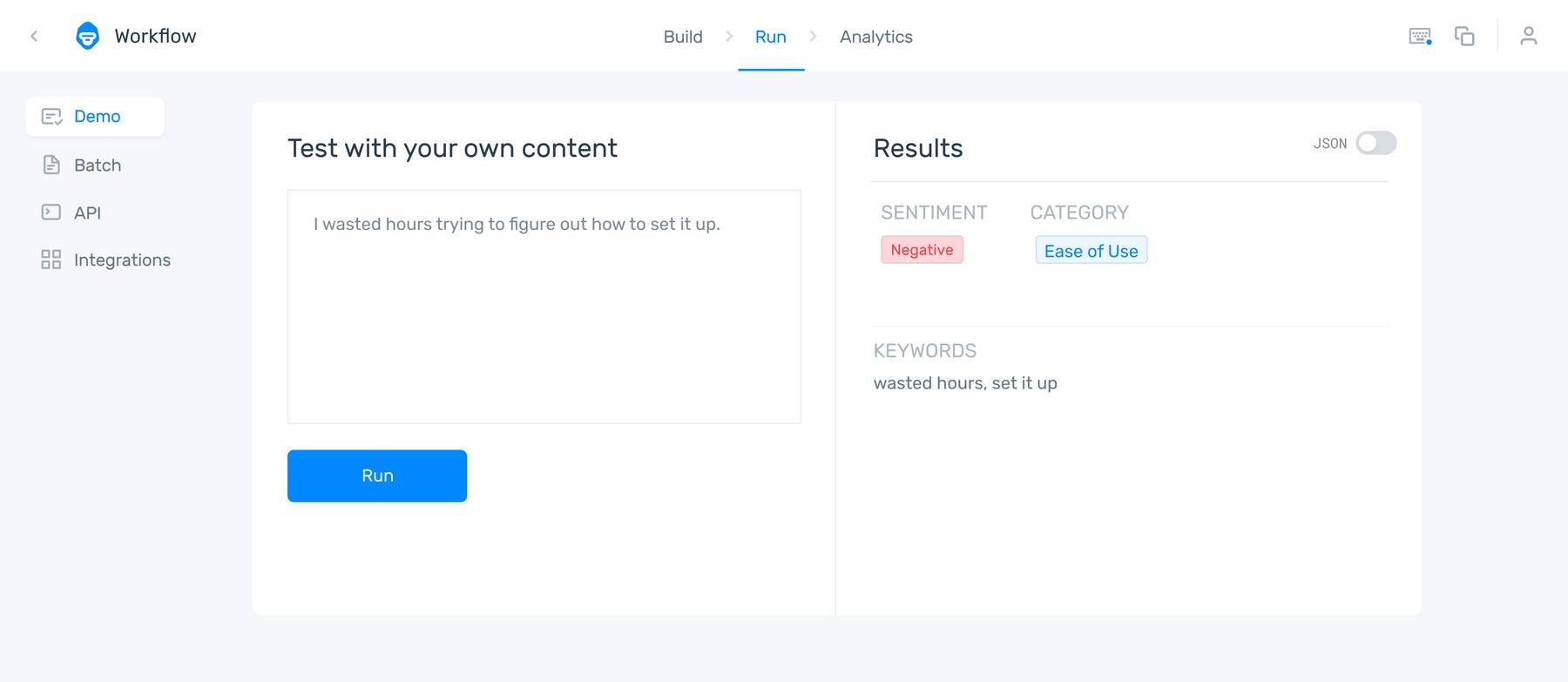Voice of Customer (VoC) Examples for Your Business

It’s likely that you ignore a lot of your customer data. And we get it. It’s a lot of data to wade through for any company.
However, when you learn how to listen to the voice of customer (VoC), you’ll start to fully understand your customers, increase customer satisfaction and improve your overall business.
Read on to learn about voice of customer examples, applications and use cases, and how you can easily listen to the voice of the customer using voice of the customer tools.
- What Is Voice of Customer (VoC)?
- The VoC Process: A Quick Explanation
- Voice of Customer Examples
- Voice of Customer Mistakes
What Is Voice of the Customer (VoC)?
Voice of the customer (VoC) is the gathering and analysis of customer data about a brand or its products and services in order to improve the company’s processes, their products and services, and overall customer satisfaction.
When digging into VoC, it’s important to remember that even negative customer feedback is helpful. In fact, negative VoC feedback is often the most helpful because it can bring to light certain customer pain points that, once fixed, can greatly improve the customer experience (CX), product experience (PX), and inform product development.
But, before digging into VoC data, you’ll need a comprehensive strategy in place.
The VoC Process: A Quick Explanation of How to Set Up Your VoC Strategy
A three-step process to setting up your VoC analysis:

1. Gather data
From internal sources (customer support interactions, emails, live chats, surveys, etc.) and external sources (online product reviews, news reports, social media comments, forums, etc.).
2. Analyze your data
You can use spreadsheets, like Excel and Google Sheets, with built-in analyses for quantitative data (mean, maximum, minimum, percentages, etc.). And some online survey applications have helpful tools, like SurveyMonkey’s data filter.
AI machine learning tools, like MonkeyLearn and MonkeyLearn Studio, can take your data even further. Try out this pre-trained survey analyzer, for example, that automatically classifies survey feedback into categories.
Request a demo to learn how to analyze your surveys with AI.
3. Act on your data
Now it's time to put your results into practice.
Maybe you’ve found out that your customers love your products, but pricing is a consistent problem. Can you lower the price?
Or, if your customer support is constantly overburdened just after purchase, maybe you need to implement a better onboarding or training program for your customers.
When you put the proper VoC program into place, you’ll understand every step of the customer journey and see results in broad strokes and super minute detail.
Voice of Customer Examples
There are a number of examples of voice of customer data you can put to work for your business to understand customer expectations, improve your products and services, increase customer satisfaction, and, ultimately, grow your sales and profits.
VoC data may appear intimidating because there’s so much of it, but that only works to your advantage. You just need to get a handle on the best places to gather it.
- Customer surveys
- Interviews & focus groups
- Website behavior
- Email, live chat & customer support
- Customer success team
- Social media & online reviews
Customer surveys
Sometimes the best way to elicit VoC opinions is to just ask your customers directly. Customer surveys can be easily presented in your app, on your website, even in person, at point of sale. Whether it’s with close-ended questions (True/False,Yes/No, etc.) that can be easy to quantify, or with open-ended questions (Why do you feel this way?) – that require a bit more analysis but can be handled with machine learning tools – surveys are often your most direct inroad to the voice of customer.
Net Promoter Score (NPS), Customer Satisfaction (CSAT), and Customer Effort Score (CES) surveys are some of the most used and most effective forms of surveys:

Online survey tools, like SurveyMonkey and Typeform, make implementing, custom-creating, and collecting VoC data easy. From there you can use SaaS text analysis tools, like MonkeyLearn, to automatically analyze even open-ended survey data to understand the VoC.
It works just the same with VoE or “voice of employee” data. Take a look at how Dell used MonkeyLearn to save hundreds of employee hours and months of analysis on over 10,000 employee surveys.
Interviews & focus groups
Customer interviews or focus groups are similar to surveys but can sometimes allow the questioners to dig in a bit more thoroughly with direct follow-up questions, to pursue the respondent’s train of thought. If they’re not performed by professionals trained to uncover unbiased information, however, focus groups can sometimes be in danger of leading the respondents into a direction that they may not have already been headed toward.
Focus groups are ideal for new product releases or potential new products to see how different demographics react in real time.
Website behavior
Use your website’s built-in tools and e-commerce applications to follow your customers’ behavior and use the data for future analysis.
A lot of this data may be strictly quantitative (page views, click throughs, purchase amounts, etc.), but when you combine it with other, qualitative VoC data, you’ll be able understand why your customers are exhibiting the behavior they are on your site.
Via Hotjar.
Email, live chat & customer support
This is internal data, mostly from customer service interactions, that you’re probably already collecting. These conversations are especially helpful to understand how well your support team is working for the customer. Machine learning tools, like sentiment analysis, can be put to work on your support data to understand the “sentiment polarity” of support tickets, without the need to read through them all manually.
Not only will this give you an idea of the major problems your customers are dealing with, but you can use it to improve existing CRM and customer support systems. Automatically tag tickets and put the most urgent support issues at the top of the queue, for example, to make sure they’re dealt with first.
Create omnichannel support that’s integrated across your company. Take a note from Jeff Bezos, who still has a public company email address. When your customers know you’re listening to their voice, they’re more trusting and, ultimately, more loyal to your company.
Customer success team
A customer success team is all about retaining customers. Your sales and marketing, R&D, and customer service teams may be clearly defined, but a customer success team is just as important – and they work in conjunction with all of the aforementioned teams.
A customer success team should be gathering customer data from all across your organization. Their aim should be to funnel all customer information together to make CX easier across the board. For example, if your customer support team is fully staffed and ready to take calls, chats, etc., but they don’t fully know how to use the product or can’t easily get in touch with the product team, the customer ends up left out in the cold.
Also be sure to use your data to properly train employees on how to work with customers. Companies like Zappos, for example, come up with consistently high CSAT marks because their employees use their VoC data to personalize the customer experience.
Social media & online reviews
Online review sites and reviews on e-commerce sites from Capterra, G2 Crowd, Angie’s List, Amazon, etc. are a huge drive for a business’s sales, so it’s important that you know what your customers are saying about your products (positive and negative).
Furthermore, reviews on e-commerce sites and social media are where customers often leave their most honest opinions. The customers simply feel compelled to voice their opinions.
Text analysis tools, like aspect-based sentiment analysis, can automatically gather reviews and social media comments and analyze them for a real-time understanding of exactly what customers are saying about your products and which aspects they’re referring to.
If you’re analyzing customer comments from YouTube, for example, you can extract comments with web scraping tools, then train machine learning models to first classify comments by sentiment: Positive, Neutral, Negative:
Then analyze them by topic or aspect, (for example, Ease of Use, Features, Pricing, etc.), so you end up with an aspect-based sentiment analysis, showing you the positivity and negativity of each aspect:

There are a number of text analysis VoC tools you can use in concert to build a personalized VoC program. But VoC analysis is only useful when performed correctly.
Voice of Customer Mistakes
Avoid these common VoC mistakes to get the most from your analysis:
Not defining goals at the beginning.
What do you need to analyze? Do you need to know how your customers use your products? Do you need to perform competitive analysis? Do you need input for possible new features or use cases? VoC can do all of these, but it’s best to start with a solid plan in mind.
Using only one method of gathering information.
You’re likely already gathering customer data from emails, live chats, CRM systems, etc. But don’t stop there, you can get customer data from all over the web.
Not using relevant tools.
Using machine learning tools will allow you to analyze both quantitative and qualitative data, so you can get the stats and percentages and the opinions and feelings of your customers.
You’ll also be able to integrate your analysis tools with customer support systems, like Zendesk, so you'll be set up for analysis and able to improve internal processes – create an omnichannel support system, for example.
Avoiding employee's feedback.
Voice of employee (VoE) is often just as important as VoC. Use the same tactics laid out above to understand your employees’ opinions: surveys, focus groups, etc, and put their feedback to use on internal issues and customer-facing processes.
Neglecting to follow up with customers.
Another great process to incorporate with VoC analysis is a customer feedback loop. Similar to VoC, a customer feedback loop (1) gathers data, (2) analyzes it, and (3) acts on the results, with the added step of “closing the loop.” Closing the feedback loop means that you follow up with your customers to let them know that you’re listening and make them aware when you’ve fixed problems or made changes based on their feedback.
Keep your communication open. Don’t forget to let your customers know that they always have your ear.
Create Your Personal VoC Solution
VoC analysis can seem intimidating, but when you learn how to gather data and use machine learning tools to analyze it, you’ll receive constant VoC analytics – 24/7 and in real time. Create your VoC solution to help your company make data-driven decisions to improve your products, your processes, and your bottom line.
Try out our demo visualization dashboard, where you can slice and dice your data by topic, keyword, sentiment, and more:

Request a demo from MonkeyLearn to see how you can use text analysis tools to take advantage of all your VoC data.

Inés Roldós
March 9th, 2021






